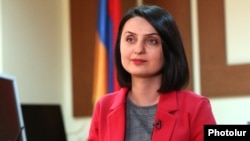Armenia’s new leadership has had trouble recruiting women for high-ranking state posts, a senior lawmaker said on Friday, commenting on a continuing lack of female presence in the government.
Armenian women have traditionally held few ministerial or other senior positions in the executive branch. This situation has hardly changed since last year’s “velvet revolution” that brought younger and more progressive individuals to power.
Only one member of Prime Minister Nikol Pashinian’s current cabinet, Labor and Social Affairs Minister Zaruhi Batoyan, is a woman. Pashinian’s first cabinet formed in May 2018 had two female ministers. One of them, Lilit Makunts, now leads the parliamentary group of the ruling My Step alliance.
Speaking on International Women’s Day, a public holiday in Armenia, Makunts insisted that the new authorities have tried hard to appoint more women to run ministries, other government agencies or provincial administrations but have so far been thwarted by conservative public attitudes.
“Nothing works out artificially,” she told reporters. “If you force a person to do things she doesn’t want to do, the quality of that work will suffer and we won’t get want we want to see in the social sense.”
“There are many [female] professionals. It’s just that social and political pressure [on them] is extremely strong,” said Makunts, who served as culture minister until January. Many women refuse to take up senior positions at the urging of their husbands and other relatives, she explained.
“Especially in the regions, it’s quite hard to find women familiar with local problems for leadership positions,” said Tsovinar Vartanian, another female parliamentarian representing My Step.
Women make up almost one-quarter of Armenia’s 132-member parliament elected in December, a record-high percentage in the country’s post-Soviet history. Twenty-three of the 32 female deputies are affiliated with Pashinian’s bloc. One of them, the 25-year-old Sona Ghazarian, is the youngest member of the National Assembly.
Makunts, 35, said that attracting more women to politics in the socially conservative country has proved just as difficult.
“Women are not forgiven for things that can be ignored in the case of men,” said the former university lecturer, who faced intense media scrutiny during her seven-month ministerial stint. “All these factors don’t allow women to be more audacious and get actively involved in [political] processes.”
Makunts made clear that the authorities will continue to seek greater female presence in the higher echelons of political and administrative power. “We will definitely work in that direction,” she said. “I find it very important. I may not be objective but I think that relationships are friendlier and compromises more commonplace in places where women are involved.”







Facebook Forum